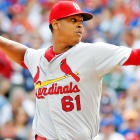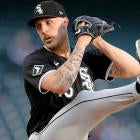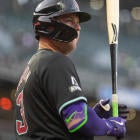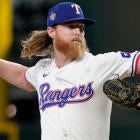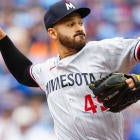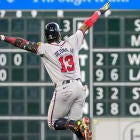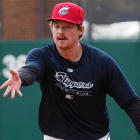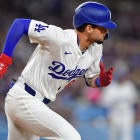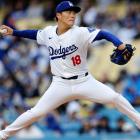"There's no such thing as a pitching prospect," you may have heard some folks say.
Yeah? Well, they're not working with the same list I am.
Two hundred fifty-three names I filtered through to arrive at this list of 30, circling back through enough times to convince myself there is no right answer -- or, conversely, a wrong one.
Granted, some didn't merit more than a quick look at their stat line. Others didn't get even that (I'm but a man, you see). But it's true: More than eight times the players who actually made this list were considered for it.
Which would suggest to me it has a high margin for error.
And that's kind of the point, right? "There's no such thing as a pitching prospect." Obviously, there is, but they fail at such a high rate that to count on any one is to count on the roll of a die. What teams lack in assurance, then, they make up for in volume. It's only in the minors, when everything is projection and no one has actually failed yet, that we see those redundancies.
So if you notice a player missing who absolutely needs to be here, rest assured he didn't miss by much. And note that when I reveal my top 100 prospects, all positions combined, the number of pitchers represented will be something closer to 50.
Note: This list is intended for a variety of Fantasy formats and thus weighs short-term role against long-term value. Not all of these players will contribute in 2017 -- most, in fact, will not -- but among prospects, they're the names to know.
1. Lucas Giolito, 22, White Sox
Where played in 2016: low Class A, Double-A, Triple-A, majors
Minor-league stats: 2.97 ERA, 1.28 WHIP, 115 1/3 IP, 44 BB, 116 K
Major-league stats: 6.75 ERA, 1.78 WHIP, 21 1/3 IP, 12 BB, 11 K
Some unexpected command issues last year damaged Giolito's stock a bit, making him less than a clear-cut top choice here, but at least at the minor-league level, he improved as the year went on, compiling a 2.17 ERA with just 2.4 walks per nine innings in his seven starts at Triple-A. No minor-league pitcher has such an impressive array of pitches or as clear an ace profile.
2. Alex Reyes, 22, Cardinals
Where played in 2016: Triple-A, majors
Minor-league stats: 4.96 ERA, 1.45 WHIP, 65 1/3 IP, 32 BB, 93 K
Major-league stats: 1.57 ERA, 1.22 WHIP, 46 IP, 23 BB, 52 K
Of all the big-name pitching prospects to get their feet wet last year, none made the impression Reyes did, dominating in a swingman role to make him an early favorite for a rotation spot. He needs to throw more strikes, no doubt, but few pitchers, accomplished or otherwise, miss bats like he does, which should more than make up for it.
3. Tyler Glasnow, 23, Pirates
Where played in 2016: Double-A, Triple-A, majors
Minor-league stats: 1.93 ERA, 1.17 WHIP, 116 2/3 IP, 68 BB, 144 K
Major-league stats: 4.24 ERA, 1.50 WHIP, 23 1/3 IP, 13 BB, 24 K
Glasnow profiles similarly to Reyes in terms of dominance and wildness, but the key difference is he hasn't succeeded against major-leaguers yet. He also has a higher margin for error at 6-feet-8, making his delivery less repeatable and potentially prolonging the control issues, but his long reach is also what makes him unhittable at times, ramping up the effective velocity of his 97-mph fastball.
4. Jose De Leon, 24, Dodgers
Where played in 2016: Triple-A, majors
Minor-league stats: 2.61 ERA, 0.94 WHIP, 86 1/3 IP, 20 BB, 111 K
Major-league stats: 6.35 ERA, 1.53 WHIP, 17 IP, 7 BB, 15 K
A former 24th-round pick, De Leon's unlikely rise continued last year with him overcoming a couple of early injuries to deliver stud numbers in a hitter-friendly league. He has demonstrated all the strikeout ability of Reyes and Glasnow and none of the control lissues, but he doesn't throw quite as hard and has shown some vulnerability to the long ball.
5. Luke Weaver, 23, Cardinals
Where played in 2016: Double-A, Triple-A, majors
Minor-league stats: 1.30 ERA, 0.93 WHIP, 83 IP, 12 BB, 92 K
Major-league stats: 5.70 ERA, 1.60 WHIP, 36 1/3 IP, 12 BB, 45 K
Weaver began last season as a so-so prospect with a broken wrist, but he recovered to pitch like someone who doesn't belong in the minor leagues, dominating Double-A for 13 starts with the kind of strikeout-to-walk ratio that would make Noah Syndergaard proud. Corey Kluber might be a fairer comparison seeing as Weaver throws in the low-to-mid-90s with sink. Now, he just needs an opening.
6. Josh Hader, 22, Brewers
Where played in 2016: Double-A, Triple-A
Minor-league stats: 3.29 ERA, 1.24 WHIP, 126 IP, 55 BB, 161 K
Beginning with a breakout performance in the Arizona Fall League, Hader pitched his way into the prospect elite last year, making the Astros wish they had never inclued him in the ill-fated Carlos Gomez deal. He was untouchable in 11 starts for Double-A Bioloxi, compiling a 0.95 ERA with 11.5 strikeouts per nine innings, before the hitter-friendly Pacific Coast League got to him late.
7. Francis Martes, 21, Astros
Where played in 2016: Double-A
Minor-league stats: 3.30 ERA, 1.21 WHIP, 125 1/3 IP, 47 BB, 131 K
Speaking of ill-fated trades, Martes has gone from being an unknown in the Marlins' acquisition of Jarred Cosart two years ago to the top prospect in an ever-deep Astros farm system. He has gained nearly 5 mph on his fastball since then, frequently hitting 97, and has refined his curveball to the point he now does a pretty mean Lance McCullers impression, only with a changeup to boot.
8. Brent Honeywell, 22, Rays
Where played in 2016: high Class A, Double-A
Minor-league stats: 2.34 ERA, 1.03 WHIP, 115 1/3 IP, 25 BB, 117 K
If the biggest stumbling blocks for pitching prospects are control and pitch variety, Honeywell is well ahead of the curve, having issued just 1.9 walks per nine innings over three seasons and developed a whopping five pitches, including a screwball that's as effective as it is unusual. His velocity and command gives him a high floor even without it, but the novelty of the pitch could set him apart.
9. Anderson Espinoza, 19, Padres
Where played in 2016: low Class A
Minor-league stats: 4.49 ERA, 1.39 WHIP, 108 1/3 IP, 35 BB, 100 K
At 18 (19 by opening day), Espinoza is still a ways away, but already he shows the kind of arsenal that will make the Red Sox regret the Drew Pomeranz trade for years to come. The numbers are almost irrelevant at this stage. Rare is the teenager who both throws 97 and packs a three-pitch arsenal -- a starting point that portends greatness.
10. Sean Newcomb, 23, Braves
Where played in 2016: Double-A
Minor-league stats: 3.86 ERA, 1.31 WHIP, 140 IP, 71 BB, 152 K
You'll hear some concern about a lack of development for Newcomb, who has battled control issues every step up the ladder, but he may well have turned the corner over his final seven starts last year, compiling a 2.04 ERA and 0.98 WHIP with 11.6 strikeouts to 3.2 walks per nine innings. He still has an overpowering fastball/curveball combo and continues to elicit Jon Lester comparisons.
11. Reynaldo Lopez, 23, White Sox
Where played in 2016: Double-A, Triple-A, majors
Minor-league stats: 3.21 ERA, 1.14 WHIP, 109 1/3 IP, 35 BB, 126 K
Major-league stats: 4.91 ERA, 1.57 WHIP, 44 IP, 22 BB, 42 K
Any hype Lopez got prior to last year was based more on projection than result, but he took a big step toward closing that gap at Double-A Harrisburg, even recording double-digit strikeouts four times in a six-start span at one point. His small stature may ultimately bump him to the bullpen, but his 11-strikeout effort against the Braves on Aug. 18 showed his potential as a starter.
12. David Paulino, 23, Astros
Where played in 2016: Rookie, Double-A, Triple-A, majors
Minor-league stats: 2.00 ERA, 1.01 WHIP, 90 IP, 19 BB, 106 K
Major-league stats: 5.14 ERA, 1.29 WHIP, 7 IP, 3 BB, 2 K
Another slow-to-materialize fleecing by the Astros, this one acquired from the Tigers for Jose Veras in 2014, Paulino looks like an ace-in-waiting, having dominated Double-A with a 1.83 ERA and unnatrual control for a 6-foot-7 pitcher. His size gives him potentially an even higher ceiling than Marte, but he'll require greater patience to meet it, having yet to throw even 100 innings in a season.
13. Mitch Keller, 20, Pirates
Where played in 2016: low Class A, high Class A
Minor-league stats: 2.35 ERA, 0.92 WHIP, 130 1/3 IP, 19 BB, 138 K
Keller upped his stock more than any other pitching prospect last year, going from second-round afterthought to possible cornerstone. He's poised beyond his years, settling for weak contact rather than giving in to a walk, but it's not like he's lacking swing-and-miss stuff, having averaged 10.9 strikeouts per nine innings (to just 1.6 walks) during his season-ending, 29-inning scoreless streak.
14. A.J. Puk, 21, Athletics
Where played in 2016: short-season Class A
Minor-league stats: 3.03 ERA, 1.07 WHIP, 32 2/3 IP, 12 BB, 40 K
Though he wasn't the first pitcher selected in the 2016 draft, Puk was arguably the best, and he didn't give any reason to dispute it in his first taste of professional ball last year. He's less polished than his age would have you believe, though, and needs to improve his command to become the workhorse his 6-foot-7 frame suggests he should be.
15. Kolby Allard, 19, Braves
Where played in 2016: Rookie, low Class A
Minor-league stats: 2.98 ERA, 1.11 WHIP, 87 2/3 IP, 25 BB, 95 K
An impending back surgery crippled Allard's draft stock in 2015 and invited questions about his durability, but in his first extended look as a professional this year he showed why the Braves still made him their top choice that year, flashing a three-pitch arsenal and poise beyond his years. He got better as the season went on, too, compiling a 2.01 ERA over his final 12 starts.
16. Michael Kopech, 20, White Sox
Where played in 2016: short-season Class A, high Class A
Minor-league stats: 2.08 ERA, 1.10 WHIP, 56 1/3 IP, 33 BB, 86 K
Kopech's claim to fame is hitting 105 mph with his fastball this year -- a feat normally reserved for Aroldis Chapman and Aroldis Chapman alone -- and he did it as a 20-year-old handling a starter's workload. Of course, throwing that hard is almost asking for injury, so if he doesn't tone it down or at least improve his efficiency, he could wind up in the bullpen.
17. Jason Groome, 18, Red Sox
Where played in 2016: Rookie, short-season Class A
Minor-league stats: 2.70 ERA, 1.05 WHIP, 6 2/3 IP, 4 BB, 10 K
The reason Puk was "arguably" the best pitcher in the 2016 draft is because Groome had a pretty good case, too, and in fact might have gone ahead of Puk if not for maturity concerns. Any lack of maturity, though, doesn't apply to his arsenal, which features a hammer curveball and developing changeup that should allow him to move quickly.
18. Yadier Alvarez, 21, Dodgers
Where played in 2016: Rookie, low Class A
Minor-league stats: 2.12 ERA, 1.03 WHIP, 59 1/3 IP, 21 BB, 81 K
The Dodgers have gone especially easy on Alvarez so far, waiting almost a year after signing him to unveil him -- and even then, against inferior competition -- but he did everything a player with his repertoire should do. With easy 100-mph heat and two developing breaking balls, his potential is sky high, but he loses some points for "strength of schedule."
19. Erick Fedde, 24, Nationals
Where played in 2016: high Class A, Double-A
Minor-league stats: 3.12 ERA, 1.22 WHIP, 121 IP, 29 BB, 123 K
The Nationals love to take advantage of the Tommy John discount on draft day and may well have struck gold again with Fedde. He doesn't have Giolito's pure stuff, but the command he showed this season, particularly in his first full year back from the procedure, gives him a clean and easy projection as another Jordan Zimmerann type, making him a safe pickup in long-term keeper leagues.
20. Triston McKenzie, 19, Indians
Where played in 2016: short-season Class A, high Class A
Minor-league stats: 1.62 ERA, 0.96 WHIP, 83 1/3 IP, 22 BB, 104 K
Though the numbers speak for themselves, McKenzie's performance becomes all the more impressive when you consider he's underdeveloped physically, sporting a fastball a few miles per hour less than it presumably will be once he adds some bulk to his 6-foot-5, 165-pound frame. His advanced pitchability makes up for it for now and gives him a ceiling well worth pursuing.
21. Robert Stephenson, 24, Reds
Where played in 2016: Triple-A, majors
Minor-league stats: 4.41 ERA, 1.36 WHIP, 136 2/3 IP, 71 BB, 120 K
Major-league stats: 6.08 ERA, 1.62 WHIP, 37 IP, 19 BB, 31 K
While McKenzie is ahead of where he should be at 19, Stephenson is behind at 24, and seeing as the Reds already had to turn to him for eight turns this year, he can only camp out on the 40-man roster for so long. A top-50 prospect each of the last three years, he gets the benefit of the doubt while he tinkers with his arsenal.
22. Sean Reid-Foley, 21, Blue Jays
Where played in 2016: low Class A, high Class A
Minor-league stats: 2.81 ERA, 1.01 WHIP, 115 1/3 IP, 38 BB, 130 K
Evaluators seem a little reluctant to embrace Reid-Foley, probably because of all the walks early in his career, but some mechanical tweaks cleared up that problem, giving him a chance to show off his stuff. His slider and curveball are both genuine swing-and-miss pitches, which explains the high strikeout rate, and with such a complete arsenal, he's at little risk of being confined to the bullpen.
23. Tyler Jay, 22, Twins
Where played in 2016: high Class A, Double-A
Minor-league stats: 3.33 ERA, 1.23 WHIP, 83 2/3 IP, 26 BB, 77 K
Jay is taking an unusual path developmentally, beginning his transition from college closer to professional starter this year, but the Twins wouldn't have taken him sixth overall last year if they didn't think he had arsenal and command to handle it. He's still learning to incorporate and sequence all four of his pitches, but he has a high ceiling and obviously a great fallback plan.
24. Carson Fulmer, 23, White Sox
Where played in 2016: Double-A, Triple-A, majors
Minor-league stats: 4.63 ERA, 1.48 WHIP, 103 IP, 56 BB, 104 K
Major-league stats: 8.49 ERA, 1.63 WHIP, 11 2/3 IP, 7 BB, 10 K
Fulmer, taken two picks after Jay in 2015, seems the more likely of the two to wind up in the bullpen right now. The former Vanderbilt ace has electric stuff but a smallish build and basically just two pitches since he has so little faith in his changeup. Michael Fulmer (no relation) eventually managed to clear that same hurdle, so hopefully the White Sox show some patience.
25. Robert Gsellman, 23, Mets
Where played in 2016: Double-A, Triple-A, majors
Minor-league stats: 3.99 ERA 1.25 WHIP, 115 IP, 31 BB, 88 K
Major-league stats: 2.42 ERA, 1.28 WHIP, 44 2/3 IP, 15 BB, 42 K
Gsellman was a non-prospect both at the start of 2016 and when he got called to the majors in late August, but he has more in common with Jacob deGrom than just the hairstyle. Both saw a jump in velocity late in their minor-league careers, and both quickly picked up the Dan Warthen slider, becoming bat-missers overnight. It's too early to tell how permanent this one's transformation is.
26. Amir Garrett, 24, Reds
Where played in 2016: Double-A, Triple-A
Minor-league stats: 2.55 ERA, 1.09 WHIP, 144 2/3 IP, 59 BB, 132 K
Garrett's background as a college basketball player devoting half his time to baseball (until recently) makes his exact upside difficult to pinpoint, which explains the disparate rankings among evaluators. Some cite his 1.75 ERA in 13 appearances at Double-A as a sign he has turned the corner, but he clearly took a step back with his promotion to Triple-A, particularly in terms of command.
27. Jeff Hoffman, 24, Rockies
Where played in 2016: Triple-A, majors
Minor-league stats: 4.02 ERA, 1.36 WHIP, 118 2/3 IP, 44 BB, 124 K
Major-league stats: 4.88 ERA, 1.72 WHIP, 31 1/3 IP, 17 BB, 22 K
With a fastball that touches 99 mph and two quality offspeed pitches, Hoffman has ace upside, but the Rockies haven't done him any favors rushing him to the big leagues two years after Tommy John surgery and before his command is even fully developed. Coors Field is no place for on-the-job learning, so even though the raw ability is similar, I'm skeptical of another Jon Gray success story.
28. Domingo Acevedo, 23, Yankees
Where played in 2016: low Class A, high Class A
Minor-league stats: 2.61 ERA, 1.13 WHIP, 93 IP, 22 BB, 102 K
From his imposing size (6-feet-6, 240 pounds) to his 100-mph fastball, Acevedo has the look of another Dellin Betances. But unlike Betances at a similar stage of development, his control hasn't eliminated him from a starting role yet. He has yet to gain much traction as a prospect because he's so far behind in terms of innings buildup, but the fallback plan has him becoming an ace reliever.
29. Jharel Cotton, 25, Athletics
Where played in 2016: Triple-A, majors
Minor-league stats: 4.31 ERA, 1.08 WHIP, 135 2/3 IP, 39 BB, 155 K
Major-league stats: 2.15 ERA, 0.82 WHIP, 29 1/3 IP, 4 BB, 23 K
Cotton wasn't really hyped in the Dodgers system even though his plus control combined with his wide separation in fastball and changeup velocity helped him pile up strikeouts in (mostly) hitter-friendly venues, and now he has some major-league success to back it up. It's a tiny sample size, of course, but it makes him a shoo-in for a rotation spot and a sleeper with a big park to call home.
30. Justus Sheffield, 20, Yankees
Where played in 2016: high Class A, Double-A
Minor-league stats: 3.09 ERA, 1.28 WHIP, 125 1/3 IP, 53 BB, 129 K
The final spot on a list with an arbitrary endpoint could go to any of a dozen candidates, but there was never a time when Sheffield wasn't a prospect. He's a little small at 5-foot-10 and could stand to walk fewer hitters, but he misses bats as a prospect should and has already made history as a critical piece in the paradigm-shifting Andrew Miller trade.













